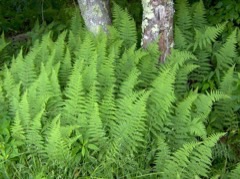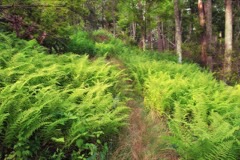 |
|
Jaknouse wikimedia.org |
 |
| Nicholas A. Tonelli wikimedia.org |
Translate this page:
Summary
Physical Characteristics

 Dennstaedtia punctilobula is an evergreen Fern growing to 0.6 m (2ft) by 0.3 m (1ft in) at a fast rate.
Dennstaedtia punctilobula is an evergreen Fern growing to 0.6 m (2ft) by 0.3 m (1ft in) at a fast rate.
See above for USDA hardiness. It is hardy to UK zone 4.
It is noted for attracting wildlife.
Suitable for: light (sandy), medium (loamy) and heavy (clay) soils and prefers well-drained soil. Suitable pH: mildly acid and neutral soils and can grow in very acid soils.
It can grow in full shade (deep woodland) semi-shade (light woodland) or no shade. It prefers moist soil.
UK Hardiness Map
US Hardiness Map
Synonyms
Aspidium punctilobum (Michx.) Sw. D. punctilobula f. punctilobula. Nephrodium punctilobum Michx. Sitobolium punctilobum (Michx.) Desv.
Plant Habitats
Edible Uses
References More on Edible Uses
Medicinal Uses
Plants For A Future can not take any responsibility for any adverse effects from the use of plants. Always seek advice from a professional before using a plant medicinally.
None known
References More on Medicinal Uses
The Bookshop: Edible Plant Books
Our Latest books on Perennial Plants For Food Forests and Permaculture Gardens in paperback or digital formats.

Edible Tropical Plants
Food Forest Plants for Hotter Conditions: 250+ Plants For Tropical Food Forests & Permaculture Gardens.
More

Edible Temperate Plants
Plants for Your Food Forest: 500 Plants for Temperate Food Forests & Permaculture Gardens.
More

More Books
PFAF have eight books available in paperback and digital formats. Browse the shop for more information.
Shop Now
Other Uses
Groundcover: Works well as a groundcover for shaded areas. Grows with a low to medium coverage density, but will quickly take over large areas and isn't advised for small gardens. Wildlife Habitat: ay scented fern provides good cover for wildlife when growing in large colonies. Ornamental: Lacy triangular fronds. Light green during summer turning shades of yellow/copper during autumn. Aromatics/Fragrance: The fronds emit a scent reminiscent of hay or cut grass when they are brushed, bruised, or crushed [318-1]. A good fern for naturalizing in woodland areas, shade gardens, cottage gardens or wild areas [368-1].
Special Uses
Food Forest Ground Cover
References More on Other Uses
Cultivation details
A temperate fern. Sun: Partial Shade, Shade. Soil Type: Sandy, Loamy, Silty, Clay. Tolerates a wide range of soils, including poor rocky soils and, once well established, dry soils [368-1]. Soil pH: 4.5 - 6.8. Soil Moisture: Moderate, Dry. Grows best in rich, humus soils. Can tolerate full sun if given enough moisture. Spreads aggressively. One of the first ferns to colonize after fire. Growth Rate: Fast. Life Span: Long-Lived Perennial. Stand Persistence: Long. Form: Clump. Texture: Medium. Root Type: Rhizome. Fungal Types: Endomycorrhizal. Seasonal Interest: Spring-Summer. USDA Hardiness Zones: 3 - 8. Drought: Tolerant. Flood: Moderate. Salt: Moderate. Soil Compaction: Tolerant. Mowing: Intolerant. Fire Damage: Moderate. Cold Injury: Infrequent. Wind Storm Damage: Infrequent. Disease Issues: Minor. Insect/Pest Damage: Minor. Animal Damage: Deer, Rabbits [318-1]. In this ecological community, you'll typically see Hay-scented Ferns growing among wildflowers such as goldenrods, hawkweeds, dandelions, Oldfield Cinquefoil, Common Evening Primrose, Field Chickweed, New England Aster, and Queen Anne's Lace. For polyculture design as well as the above-ground architecture (form - tree, shrub etc. and size shown above) information on the habit and root pattern is also useful and given here if available. The plant growth habit is a runner spreading indefinitely by rhizomes or stolons [1-2]. The root pattern is rhizomatous with underground stems sending roots and shoots along their length [1-2].
References Carbon Farming Information and Carbon Sequestration Information
Temperature Converter
Type a value in the Celsius field to convert the value to Fahrenheit:
Fahrenheit:
The PFAF Bookshop
Plants For A Future have a number of books available in paperback and digital form. Book titles include Edible Plants, Edible Perennials, Edible Trees,Edible Shrubs, Woodland Gardening, and Temperate Food Forest Plants. Our new book is Food Forest Plants For Hotter Conditions (Tropical and Sub-Tropical).
Shop Now
Plant Propagation
Propagate by spores or rhizome division. Cut rhizomes between fronds, set apart and trim back at least half of each frond.
Other Names
If available other names are mentioned here
Eastern hayscented fern, Hay-scented fern
Native Range
NORTHERN AMERICA: Canada, Québec, Nova Scotia, Ontario, Prince Edward Island, New Brunswick, Newfoundland and Labrador, United States, Connecticut, Indiana, Maine, Massachusetts, Michigan, New Hampshire, New Jersey, New York, Ohio, Pennsylvania, Rhode Island, Vermont, West Virginia, Illinois, Wisconsin, Montana, Alabama, Arkansas, Delaware, Georgia, Kentucky, Maryland, North Carolina, South Carolina, Tennessee, Virginia,
Weed Potential
Right plant wrong place. We are currently updating this section.
Please note that a plant may be invasive in one area but may not in your area so it's worth checking.
Quickly take over large areas and isn't advised for small gardens.
Conservation Status
IUCN Red List of Threatened Plants Status :

Growth: S = slow M = medium F = fast. Soil: L = light (sandy) M = medium H = heavy (clay). pH: A = acid N = neutral B = basic (alkaline). Shade: F = full shade S = semi-shade N = no shade. Moisture: D = dry M = Moist We = wet Wa = water.
Now available:
Food Forest Plants for Mediterranean Conditions
350+ Perennial Plants For Mediterranean and Drier Food Forests and Permaculture Gardens.
[Paperback and eBook]
This is the third in Plants For A Future's series of plant guides for food forests tailored to
specific climate zones. Following volumes on temperate and tropical ecosystems, this book focuses
on species suited to Mediterranean conditions—regions with hot, dry summers and cool, wet winters,
often facing the added challenge of climate change.
Read More
Expert comment
Author
(Michx.) T. Moore
Botanical References
Links / References
For a list of references used on this page please go here
Readers comment
| Add a comment |
|
If you have important information about this plant that may help other users please add a comment or link below. Only comments or links that are felt to be directly relevant to a plant will be included. If you think a comment/link or information contained on this page is inaccurate or misleading we would welcome your feedback at [email protected]. If you have questions about a plant please use the Forum on this website as we do not have the resources to answer questions ourselves.
* Please note: the comments by website users are not necessarily those held by PFAF and may give misleading or inaccurate information.
To leave a comment please Register or login here All comments need to be approved so will not appear immediately.
|
Subject : Dennstaedtia punctilobula
|
|
|
|